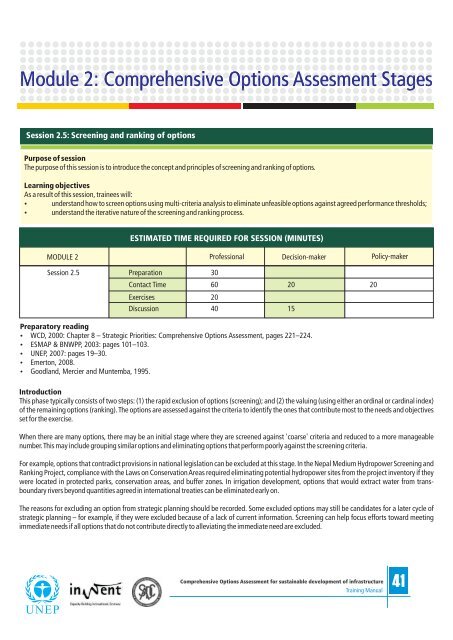Comprehensive Option Assesment - UNEP
Comprehensive Option Assesment - UNEP
Comprehensive Option Assesment - UNEP
Create successful ePaper yourself
Turn your PDF publications into a flip-book with our unique Google optimized e-Paper software.
Module 2: <strong>Comprehensive</strong> <strong>Option</strong>s <strong>Assesment</strong> Stages<br />
Session 2.5: Screening and ranking of options<br />
Purpose of session<br />
The purpose of this session is to introduce the concept and principles of screening and ranking of options.<br />
Learning objectives<br />
As a result of this session, trainees will:<br />
understand how to screen options using multi-criteria analysis to eliminate unfeasible options against agreed performance thresholds;<br />
understand the iterative nature of the screening and ranking process.<br />
ESTIMATED TIME REQUIRED FOR SESSION (MINUTES)<br />
MODULE 2 Professional Decision-maker Policy-maker<br />
Session 2.5<br />
Preparation<br />
30<br />
Contact Time<br />
60<br />
20<br />
20<br />
Exercises<br />
20<br />
Discussion<br />
40<br />
15<br />
Preparatory reading<br />
WCD, 2000: Chapter 8 – Strategic Priorities: <strong>Comprehensive</strong> <strong>Option</strong>s Assessment, pages 221–224.<br />
ESMAP & BNWPP, 2003: pages 101–103.<br />
<strong>UNEP</strong>, 2007: pages 19–30.<br />
Emerton, 2008.<br />
Goodland, Mercier and Muntemba, 1995.<br />
Introduction<br />
This phase typically consists of two steps: (1) the rapid exclusion of options (screening); and (2) the valuing (using either an ordinal or cardinal index)<br />
of the remaining options (ranking). The options are assessed against the criteria to identify the ones that contribute most to the needs and objectives<br />
set for the exercise.<br />
When there are many options, there may be an initial stage where they are screened against 'coarse' criteria and reduced to a more manageable<br />
number. This may include grouping similar options and eliminating options that perform poorly against the screening criteria.<br />
For example, options that contradict provisions in national legislation can be excluded at this stage. In the Nepal Medium Hydropower Screening and<br />
Ranking Project, compliance with the Laws on Conservation Areas required eliminating potential hydropower sites from the project inventory if they<br />
were located in protected parks, conservation areas, and buffer zones. In irrigation development, options that would extract water from transboundary<br />
rivers beyond quantities agreed in international treaties can be eliminated early on.<br />
The reasons for excluding an option from strategic planning should be recorded. Some excluded options may still be candidates for a later cycle of<br />
strategic planning – for example, if they were excluded because of a lack of current information. Screening can help focus efforts toward meeting<br />
immediate needs if all options that do not contribute directly to alleviating the immediate need are excluded.<br />
<strong>Comprehensive</strong> <strong>Option</strong>s Assessment for sustainable development of infrastructure<br />
Training Manual<br />
41
















